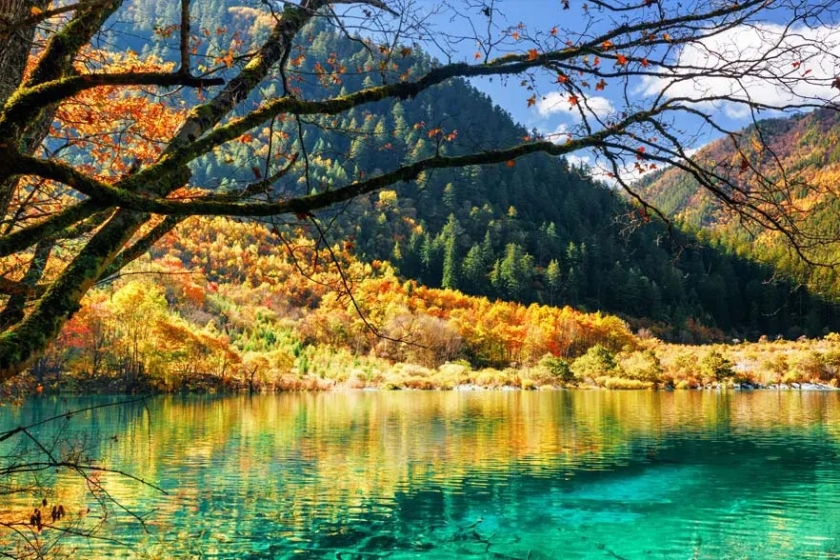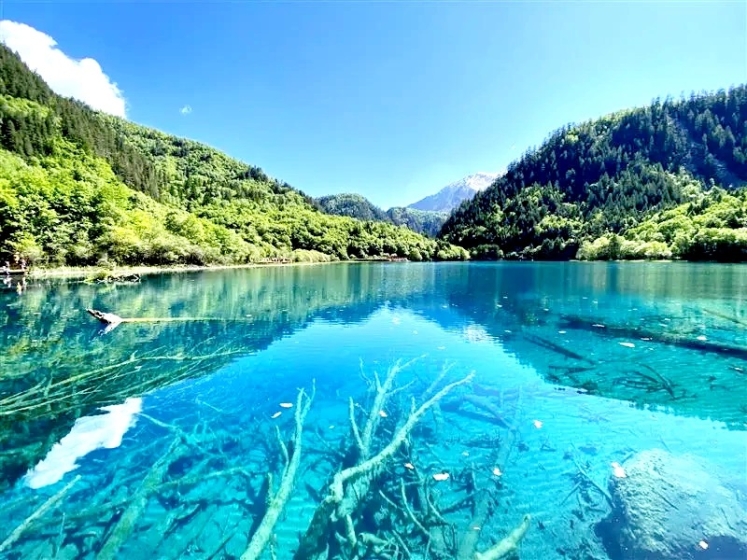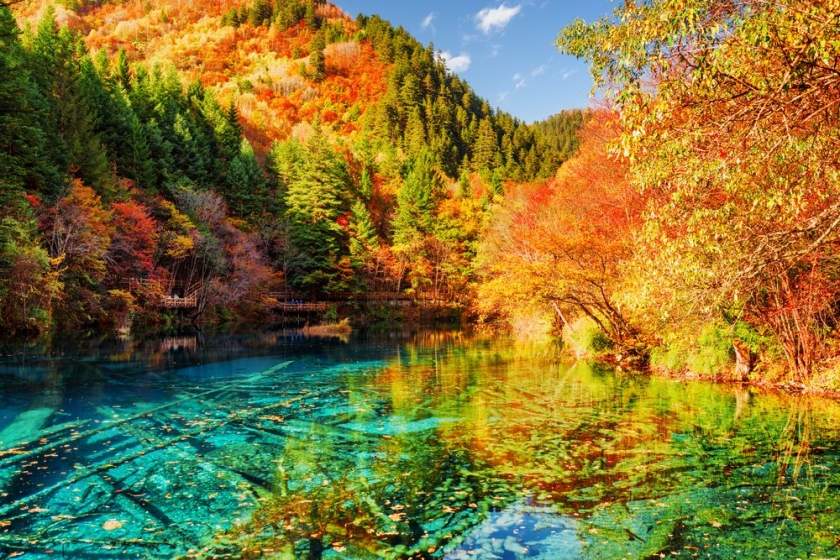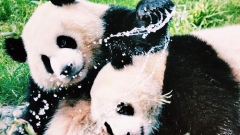Nestled in the high-altitude mountains of northern Sichuan Province, China, Jiuzhaigou Valley (literally “Valley of Nine Villages”) is nothing short of a natural wonder. It captivates visitors with shimmering jade lakes, dramatic travertine waterfalls, lush forests, snow-covered peaks and centuries-old Tibetan villages. Inscribed as a UNESCO World Heritage site, it now stands as one of China’s most iconic destinations for nature-lovers, photographers and culture-seekers alike.
Why Visit Jiuzhaigou
Jiuzhaigou offers an extraordinary combination of scenic beauty and cultural depth:
- Lakes in surreal colours – Over a hundred plateau lakes reflect greens, blues and golds depending on the light, mineral content and surrounding vegetation.
- Travertine waterfalls and terraces – The geology of the region forms layered calcified waterfalls, natural dams and cascading water features that few places match.
- Tibetan and Qiang cultural heritage – Scattered Tibetan villages set among the valleys invite you to experience local customs, crafts and the genuine pace of mountain life.
- Year-round appeal with seasonal variety – Whether you visit in spring, summer, autumn or winter, the park transforms and offers a fresh perspective each time.
- Photography paradise – For professional or enthusiast photographers, Jiuzhaigou is one of China’s most-photographed locations—lakes like Five-Flower Lake, Mirror Lake and landscapes framed by snow and forest will leave lasting memories.
Best Time to Visit Jiuzhaigou
Timing your trip wisely will enhance what you see and how you experience it.
Spring (March – May)
As the snow melts and streams swell, fresh buds appear and many lakes flood into rich tones of green and blue. The crowds are lighter than peak season but expect some variable weather and residual melting. Bring layers.
Summer (June – August)
Climate here stays much cooler than lowland China, offering welcome relief from summer heat. Waterfalls are at their fullest and the forest canopy rich. Rain and afternoon clouds are more common, so include a rain-jacket.
Autumn (September – Early November) (Recommended Peak Time)
This is widely considered the best time to visit. The forests blaze with red, orange and gold; the lakes mirror these hues in stunning contrast. Mornings are calm so reflections are sharp. Naturally this also means higher numbers of visitors.
Winter (December – February)
A quieter season, when frost and snow cloak the valleys and lakes in icy beauty. Fewer crowds and lower rates, but access may be more limited and some roads or spots may close due to snow.
Note: Because of altitude and weather, always check current conditions and be prepared for rapid change.
Understanding the Layout of Jiuzhaigou: The Y-Shaped Valley
One of the distinctive features of Jiuzhaigou is its Y-shaped structure. The three main branches each offer something special.
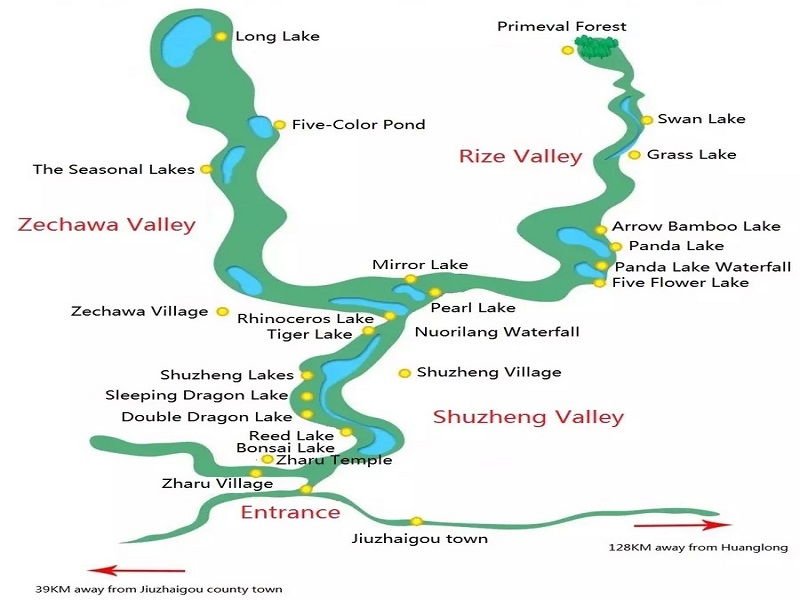
Jiuzhaigou Travel Route
Shuzheng Valley (Bottom Branch)
From the park entrance you’ll first enter the Shuzheng branch, about 14–15 km long. It features an array of lakes and smaller waterfalls, and gives you a gentle entry into the park before moving to the higher altitudes.
Highlights include: Sparkling Lake, Tiger Lake, Rhino Lake, and the dramatic Nuorilang Waterfall (some sources credit it as China’s widest high-altitude waterfall).
While many attractions are nearby and easily reached, if you spend too much time here you may not have enough left for the other branches.
Rize Valley (Right Branch)
Often described as the most scenically rich of the three. This 18 km valley contains some of the most iconic spots: eg. Five‑Flower Lake, Mirror Lake, Swan Lake, Panda Lake and Pearl Shoal Waterfall.
Because of its visual variety and the concentration of spectacular lakes, allocate plenty of time here to enjoy the views, boardwalks and photo-stops.
Zechawa Valley (Left Branch)
The highest altitude branch and the least crowded, but still deeply rewarding. Highlights are the vast Long Lake (over 7.5 km long) and the vivid Five‑Colour Pond (or Five-Colour Lake). Because of altitude it’s advisable to move more slowly, and allow time for the walkabouts.
What to See & Do at Jiuzhaigou
Here are some of the top attractions grouped by valley to help you map your visit.
Shuzheng Valley
- Nuorilang Waterfall: Wide and dramatic, this waterfall is a signature image of the park.
- Rhino Lake & Tiger Lake: Situated along a trail of lakes in vivid blue-green tones.
- Sparkling Lake & Bonsai Pool: Near the entrance, they offer a gentle start to your journey through water and boardwalks.
Rize Valley
- Five-Flower Lake: Shallow but profound, with underwater tree trunks visible in the clear waters; in autumn the colours are unforgettable.
- Mirror Lake: Especially in the early morning when the surface is calm, you’ll get perfect reflections.
- Pearl Shoal Waterfall: Broad and elegant; the premium photo-op here.
- Swan Lake & Panda Lake: Smaller lakes but with character and lesser crowds.
Zechawa Valley
- Long Lake: Expansive and serene, stretching away from the peaks; quieter and very atmospheric.
- Five-Colour Pond: A short walk from Long Lake, it’s a vivid display of mineral-rich waters shifting through tones of blue and green.
- Primeval forest and higher altitude trails: For those with stamina and time, the woodland backdrop is deep and immersive.
Cultural and Additional Activities
- Visit the traditional Tibetan villages inside and outside the park region to gain insight into local customs, dress, and way of life.
- Attend a Tibetan folk show, join a bonfire party or enjoy a yak-butter-tea tasting — all add depth beyond the scenic highlights.
- Photography is a major reason to come — bring a good lens, tripod (if you enjoy), and aim for early morning or dusk for the best light.
- Nature walks & boardwalks: Many of the lakes are accessed via wooden walkways making it easy even if you’re not a hardcore hiker.
- Combine with nearby attractions such as Huanglong Scenic Area for a full western-Sichuan adventure.

How Many Days Should You Stay at Jiuzhaigou?
For most international visitors:
- 2 days: Ideal for a full first day exploring Rize + Shuzheng, then half a day in Zechawa or strolling relaxed.
- 3 days: Gives you more breathing room, allows you to explore more slowly, include a village visit or add Huanglong.
- 1 day: Possible if your time is extremely limited — you’ll see the main highlights but have to move fast and skip side-trails.
Aim to stay overnight near the park entrance zone so you’re fresh for the early start.
Getting There & Getting Around Jiuzhaigou
Getting to Jiuzhaigou
Most routes begin in the regional hub of Chengdu.
- By Plane: From Chengdu’s airports you can fly to Jiuzhai Huanglong Airport (sometimes called Jiuzhaigou Huanglong Airport). From there it’s another road transfer (typically 1–2 hours) down to the park.
- By High-Speed Train + Road: A newer and increasingly popular option: train from Chengdu to Huanglong-Jiuzhai station, then transfer by car/bus to the park entrance.
- By Road / Bus / Car: Traditional route by coach or private car from Chengdu (approx 4–6 hours depending on stops and road/altitude conditions).
Tip: Choose based on your tolerance for mountain roads, motion-sickness, time and budget.
Getting Around Within the Park
Once inside the park, there is a well-organised shuttle bus system covering all three valleys and major scenic points. Many walks or boardwalks link lakes and sites.
- Take the bus to the farthest points (often Rize or Zechawa ends) then walk downhill or back-towards the junction to maximise views and reduce altitude impact.
- Comfortable walking shoes are essential; some areas involve moderate trail walking, though not highly technical.
- Respect the park rules and follow the boardwalks.
Practical Information & Tips about Jiuzhaigou
Tickets & Fees
- Online booking of tickets is required in advance; onsite walk-in tickets are often not available.
- Peak season and off-season fees may differ. Peak season (April 1th to November 15th) – 190 RMB ; Off season(November 13th to March 31th ) – 80 RMB.
- Ticket packages often include both park entry and shuttle-bus access.
Altitude, Weather & Health
- Elevation in parts of the park can reach over 3 000 m. While not extreme for healthy travellers, you may feel shortness of breath, fatigue or slight dizziness if unacclimatised.
- Bring warm layers, as temperature drops quickly in shadows or after sunset. UV is stronger at altitude, so sunscreen, sunglasses and hat are recommended.
- If you have serious cardiovascular, respiratory or altitude-sensitive conditions, consult your doctor in advance.
Behaviour & Conservation
- Stay on boardwalks and marked paths — the unique travertine deposits, lakes and ecosystems are delicate.
- Do not feed wildlife or fish, or remove any natural materials.
- Avoid loud behaviour; preserve the serenity and natural ambiance.
What to Pack
- Good walking shoes or boots (grippy soles recommended on damp boardwalks).
- Layers: T-shirt, fleece/jacket, windbreaker and potentially insulated layer.
- Lightweight rain-shell or umbrella.
- Sun protection: hat, sunglasses, sunscreen.
- Camera, extra batteries/memory cards.
- Water bottle/snacks (though there are dining facilities inside, they may be limited or costly).
Accommodation & Dining
- Stay in the township near Jiuzhaigou’s entrance or in the resort zone outside the park for convenience.
- Choose hotels that consider altitude comfort if needed (oxygen-rooms, warm-up services).
- Dining inside the park is limited and may be crowded during peak times — early lunch or picnic back-up is smart.
Avoiding the Crowds
- Enter the park early in the morning (first shuttle bus) to get ahead of the rush.
- Choose less-visited spots or the higher altitude Zechawa Valley for more tranquillity.
- Off-peak seasons (winter/early spring) offer quieter experience but check access and weather.

Jiuzhaigou Summer
Sample Jiuzhaigou Itinerary : 2-Day Stay
Day 1
- Early arrival, check into hotel near the park entrance.
- Enter the park at opening, take the shuttle to the far end of Rize Valley. Explore Five-Flower Lake, Mirror Lake, Pearl Shoal Waterfall.
- Mid-afternoon move to Nuorilang junction and follow parts of Shuzheng Valley: Tiger Lake, Rhino Lake, Sparkling Lake.
- Evening relax at the hotel, maybe enjoy Tibetan dinner or folk show.
Day 2
- Early morning into Zechawa Valley: hike (or boardwalk) to Long Lake and Five-Colour Pond.
- Later return via bus to collect any previously skipped sites in Shuzheng or Rize.
- Afternoon departure or continue onto nearby scenic area (e.g., Huanglong) depending on next stage.
Top Jiuzhaigou Group Tour:
7-Day 6-Night Chengdu, Jiuzhaigou & Mount Emei Tour
Why Choose China Dragon Travel
As you plan your Jiuzhaigou journey, consider letting a specialist tour agency ensure a seamless experience. At China Dragon Travel we offer tailored packages that cover: airport transfers, high-speed train bookings, acclimatisation-aware itineraries, village-culture visits, professional photography stops, and personalised attention every step of the way. Whether you’re travelling solo, as a couple or in a small group, our expertise ensures you maximise your time in this alpine wonderland — without the stress of logistics.
When you’re ready, contact our team to explore our “Jiuzhaigou & Huanglong” package, and let us design your perfect high-plateau escape.



